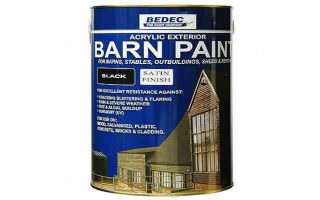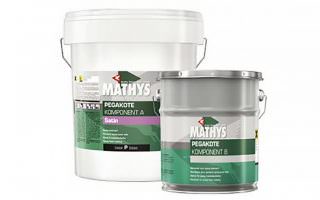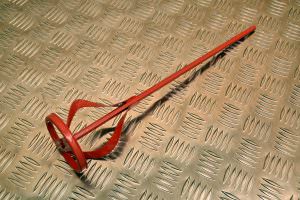Promain’s Technical Department receive a lot of queries such as ‘’the paint is a different colour to what the tin says” or “the paint has dried in some places but not in others’’. To avoid these errors you must ensure that you mix the paint correctly before application. As simple as it sounds there is a technique to mixing paints. It is an important step of the painting process that should not be ignored.
Certain types of paint are more susceptible to the solids settling at bottom of the tin. This is extremely obvious in many water based acrylic paints. Promain overcome this by placing the tins in our industrial paint shaking machine. This shakes the can from side to side as well as spinning the tin up side down. This aggressive method ensures all the solids and liquid paint mix together making it solvent. We do understand that not everyone has access to such equipment, and that people do store paint for some time before they intend to use the product. So the question is, how do you mix paint thoroughly without an industrial paint shaker?
Below we will detail the two most common type of paints and the techniques we recommend for mixing. This will help to ensure all of the paints ingredients are properly combined before application.
Single Pack Paints
Single pack paints are tins of paint supplied in a single container, which are ready to use. You do not need to mix a hardener with the paint. The term ‘’single pack’’ can refer to both water based and solvent/oil based paints.

Single pack paints such as Bedec Barn Paint, which is a water based acrylic, are susceptible to separation when stored for periods of time. We have a lot of people calling into our technical department confused as to why the paint is a different colour to the one stated on the tin. The reason is all the paint solids have settled at the bottom and what your seeing is in fact the paint solvent, the paints liquid ingredient. After mixing properly the colour will return and the paint is ready for application.
Avoid Using a Stick or Cane
The temptation when mixing a single pack is to stir the paint with a stick you might just happen to have laying around or often a garden cane is used. The trouble using this technique is that generally a stick does not have enough surface area to properly agitate the paint.
The most effective method to mix a single pack paint is to first give the tin a good shake. Ensure you hold the lid tight to avoid a messy spill. We suggest the use of a purpose made paint stirrer (a paint stirrer is either made of plastic or wood and resembles a cricket bat in shape) to mix the product. The aim is to ensure you achieve a good homogenised mix. The most effective method of ensuring a thorough mix is to use a paddle mix attached to a power drill on a low speed setting. Employing either of these methods will ensure all of the paint ingredients are properly combined guaranteeing a thorough mix.
Mixing Two Pack Paints
2 pack paints, often known as two component paints, are those which come in 2 separate tins, namely a base and an activator. You will need to mix these together prior to use. A common type of 2 pack paint used are water based epoxy floor paints.

When we talk about mixing 2 pack paints, such as Rust-Oleum Pegakote Floor Paint for instance, the importance of ensuring an even homogeneous mix really does become important as poor mixing of 2 pack paints can lead to disastrous effects. When you mix a two pack paint you are initiating a chemical reaction which then starts the paints curing process. A poor mix could lead to the paint curing too fast or areas where the activator has not been mixed with the paint. If done correctly paint will dry completely. If you do not mix the paint adequately it will dry in patches, or worst not dry at all.
How to Mix 2 Pack Paint Correctly
So how do you mix a 2 pack paint correctly? Firstly, it is almost impossible to mix more than a 1 litre tin of 2 pack paint by hand. You will require a paddle mix and power drill to carry out correct mixing.
Two pack paints will be supplied in 2 components or tins. The base is normally the larger of the tins and the activator the smaller. Both will be pre measured for the correct mixing ratio. The manufacturers will always insist that you do not part mix as this can lead to incorrect quantities being used resulting in areas that may not dry.
As previously discussed, 2 packs come in two components typically a base and an activator. When storing paint the solids can settle. It is therefore a good idea to give the base component a mix with the paddle mix and power drill on a low speed setting to thoroughly mix the components together.
Aim For A Smooth Consistent Pour
In many cases the tin of base will be large enough to receive the hardener and allow for mechanical mixing. Now add the activator. Although it may seem tempting do not just pour the whole content of the tin into the base. You need to aim for a smooth consistent pour whilst mixing with the paddle mix and power drill on a low speed setting. Continue adding and stirring until both components have been evenly combined and you have achieved a homogeneous mix. The manufacturers publish Product Data Sheets which contain guidelines to the amount of time the paint requires.

Following the mixing of both components, a tip is to have a paint scuttle to hand. Use this to decant your mixed 2 pack paint into. Next using a spatula, give the now empty tin a scrape round the edges and bottom and add this into the paint scuttle. Give the paint a final mix with the paddle mix and power drill. This will ensure any last remnants of either of the components are thoroughly mixed.
Always Remember The Pot Life!
A tip when using a 2 pack paint is to remember it has a pot life. This is the period of time in which you can use the paint. This can range from as little at 10 minutes up to 8 hours or more. This can vary depending upon the ambient temperature and often many coatings will not harden below 5°C.
We recommend you plan the job ahead. Ensure all the preparation is complete before you mix the paint and if necessary employ some extra help. Another point to consider is container size and pot life (the working time of the paint). Plan the job by purchasing a combination of smaller and larger tins e.g. smaller sizes for cutting in around the edges and any objects and then larger sizes to fill in the large open areas. Purchasing paint this way will ensure you do not waste a large container when undertaking the more time consuming parts of the project. Care should be taken that all the tins are from the same batch to ensure colour consistency.
Other Types Of Paint
You can mix most other types of paint in the same way as single pack paints. Please always consult the manufacturers technical data sheet prior to use so as you can be sure you are mixing and using the paint correctly. Also consider the use of PPE such as a face mask as some paints contain strong solvents such as Xylene. Always use gloves when using solvent based prints as the solvent can damage your skin.
In any doubt about mixing or applying any of the products supplied by Promain? Please do not hesitate to call our technical department on 01462 421 333.
Want to read more? Have a look at these:
- How To Stop Rust?
- How To Paint uPVC Window Frames and Doors
- FAQ: Which Masonry Paint Is Best?
- How To Choose Fence Paint Colours
- Feature Walls: Inspirational Teal
Or look at our 2 pack paint categories:

